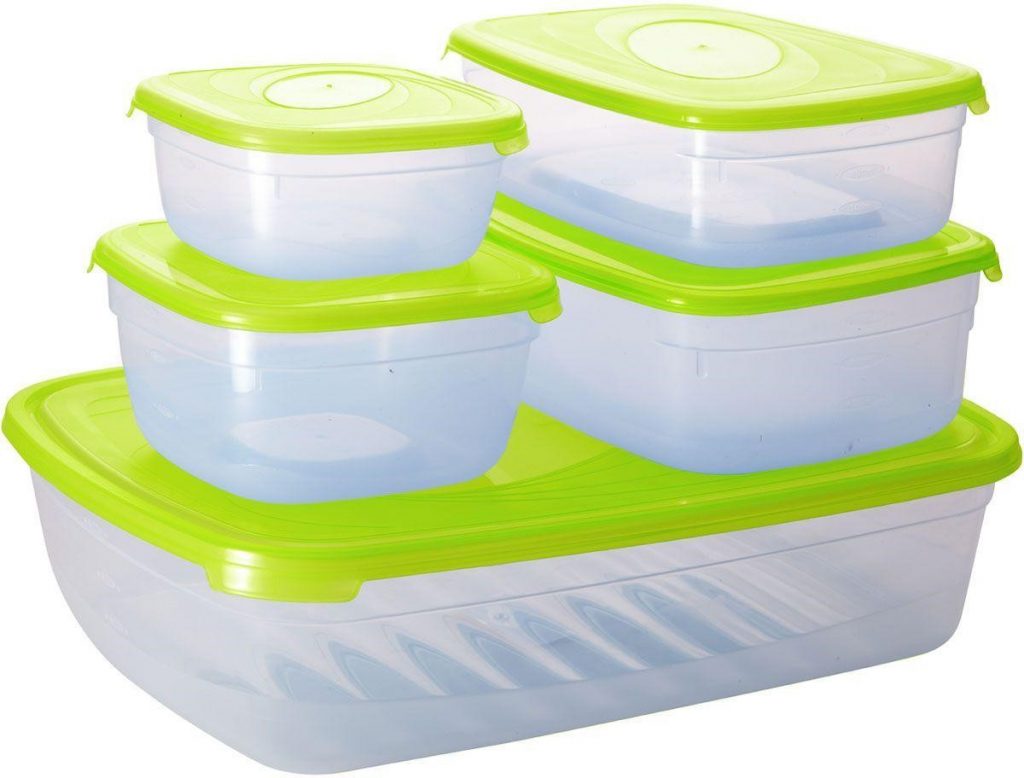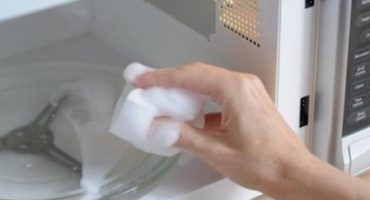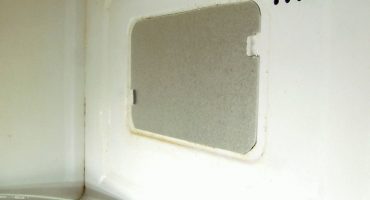It is difficult to imagine life without the convenience that a microwave gives. Take at least a warming up of any dish in a couple of minutes. More experienced users have mastered cooking and are also satisfied. Roasting, cooking, heating, stewing or steaming, grilling, defrosting - it is very difficult to list all the possibilities that this reliable assistant gives.
There are very few restrictions when working with a microwave. The main one concerns the material from which a container that can be irradiated can be made. Sometimes a hint for a microwave icon on a dish can serve as a hint, and if it’s not, how can I understand it? After all, the use of the wrong material will disable the equipment or adversely affect people's health.

Protective plastic cover for protection against splashes and moisture loss
What utensils can be used in the microwave?
Microwave Marking Examples
A general ban on everything that is prohibited for a microwave oven is - “No metal!”. Metallic or metallized spraying, a reinforcing mesh, pens, funnels, seals or microinclusions of metal will cause sparks to jump inside the chamber, the magnetron will spark, and the equipment will fail.
For all microwave oven modes, these types of containers are suitable:

Types of dishes for microwave ovens
- Glass. Almost all types of glass trays, pots, salad bowls or forms made of heat-resistant glass are suitable for any regime of a microwave oven. Thin-walled glass is suitable only for short-term heating of the liquid. They allow radiation, the food looks aesthetically pleasing, you can follow the cooking process, just look after it, plus it is durable (if you don’t throw it or put it hot on a cold table). Manufacturers of household appliances recommend taking round or oval glassware, warming up plus cooking goes faster, more evenly.
- Silicone Quickly conquering the market, silicone products for the kitchen got to the microwave. Now on the market you can find a huge assortment of baking dishes from multi-colored food-grade silicone. It allows you to cook without oil, it is easy to clean, not afraid of a dishwasher or high temperatures, has a non-stick property plus is quite durable. It is important to take products from trusted manufacturers, only food grade silicone.

Sample Silicone Product
Plastic Trays, containers, pallets or cups made of polymers are often used by housewives. But for the microwave oven you need a special plastic - heat-resistant plus suitable for microwave exposure. Otherwise, the output will be a deformed piece of plastic. There are types of plastic in which you can only heat it up, that is, heat it for a short time, and it is not recommended to cook, especially with fat. What type of polymer is suitable for a microwave oven can be found by marking on the walls or bottom.

Reception of plastic containers
- Clay. This includes ceramic, earthenware, porcelain or earthenware utensils - any that includes clay, no inclusions or metal decor. The food in it heats up and cooks a little worse, since it does not pass microwaves well. First, the walls warm up, and only then - the food, so you need to follow all safety rules when taking it out of the oven. Care must be taken to ensure that there are no cracks on the surface - due to the temperature difference, such a broken cup or plate will simply burst during heating.
- Paper.Food, packed in paper bags, envelopes, plus polyethylene or film - all this is suitable for use in the microwave only for heating, but not for long, a couple of minutes. Otherwise, the film will begin to melt or even light up.

Food in a package that can be heated in a microwave oven
- Tissue. In linen or cotton napkins, it is convenient to heat flour products, bakery.
On containers that can be used in microwave ovens, there is a special marking to understand its purpose.

Samples of the symbols on the dishes
Marking utensils for microwave ovens
Such symbols mean that dishes can be irradiated with microwaves without difficulty:

Microwave Icons
If such icons are crossed out, then use in microwaves is strictly prohibited.
Plastic that can be used in microwave ovens

Plastic marking
If it can be frozen or exposed to low temperatures, there will be an image of snowflakes. The more snowflakes, the lower the temperature the material withstands.
Plastic marking

Plastic, its types and designations
If the plastic products have a triangle of arrows with the number 6 inside and the abbreviation PS, then this means that the polymer is polystyrene, which means you cannot heat it, pour it hot or use it in a microwave oven!
If the designation is the number 5 plus PP, then this is the mass of polypropylene. Such containers can be used in a microwave oven, but without the use of alcohol, which, as a result of a chemical reaction, will release formaldehyde and phenol, which, when taken orally, can lead to blindness.
The icon on the plastic in the form of a glass and a fork means that the product tolerates high temperatures well, it is intended for food products. It allows you to warm or keep food. If such a sign is crossed out, then this indicates the opposite - non-food plastic.
Special dishes for a microwave oven have a symbol in the form of a microwave oven and a plate inside it.
All other types of plastics produce toxic substances when heated, can be hazardous to health, especially if they are exposed to heat or microwave exposure.
Prohibition topic or metal utensils
You need to be very careful that the knife or fork does not get into the microwave, that there is no pattern on the plates with metal additives, otherwise the electric charge will accumulate, then the oven will fail - the magnetron will deteriorate, without which there will be no microwave waves, and the replacement of which costs half the cost instrument.
Forbidden dishes for the microwave:
- Any types of metal utensils. All metals do not allow microwaves to pass, they accumulate an electric charge, that is, food does not heat up, but metal walls are heated, sparks arise, equipment breaks down.
- Container of any material with drawings of paints, which includes metal. This is clearly visible when it is heated, sparks. You need to immediately turn off the furnace, get a metal threat.
- Natural crystal. Uneven walls, inclusions of metal microparticles will lead to the fact that under the influence of microwaves, crystal products turn into small fragments.
- Foil dishes. It would seem that everyone understands that it is strictly forbidden to use metal foil in microwave ovens, but people mistakenly grill foil in the foil, breakfast or semi-finished products, oven-baked products, which cause irreversible damage to the magnetron.
- Wax paper packaging. Semi-finished products, various ready-made dishes of industrial production, all this can be warmed up if the package contains such recommendations from the manufacturer, but only once.
- Pottery without glaze. Thick clay walls are heated unevenly, can crack in the microwave. And even in them the food remains cold, even if the plate itself is heated, it is impossible to touch.
- Thin-walled glass. Such products do not withstand heat, most often burst when heated for too long.
- Capacities of any type with microcracks. When the container plus the contents are heated, an uneven expansion occurs, therefore, most likely, the bursting thing will break into pieces.
- Wooden crafts. Usually they either dry out or are charred in microwave ovens.
- Plastic film. It is permissible to use only those types of polymeric materials on which there is a corresponding marking, otherwise the products will be deformed or will release toxic substances into food. Of the huge amount of food and non-food plastic, only polypropylene can be irradiated with microwaves without harm to health, it is also labeled with the number 5 or PP.
Microwave Cooking Tips
To make the purchased dishes suitable for any cooking regime in the microwave, it is better to immediately take the universal or not to be confused when you choose such modes with convection, grill or combined, when there is exposure to high temperatures.
Tips for choosing dishes:
- It is better to take heat-resistant products (it should withstand more than 220 ° C, optimally - up to 300 ° C).
- The walls of the products must pass microwaves without interference - that is, not to be too thick, not to have any inclusions or coating with metal.
- It must be intact, air bubbles inside the material or defects are also not allowed.
- Test for heating - the selected container is filled with water, heated from a minute to a boil. Ideal dishes will be moderately hot with boiled water nutria.
The microwave opens up endless possibilities for the hostess with imagination. A lot of modes, a programming function, and at the finish line - almost any dish with the preservation of nutrients in a minimum amount of time.



Thank you, very useful article.